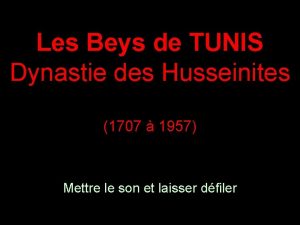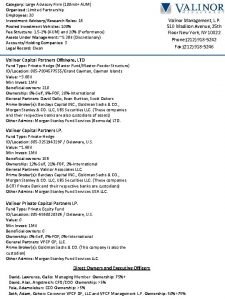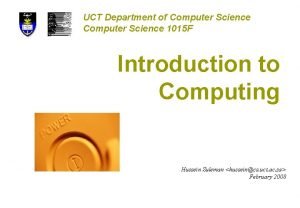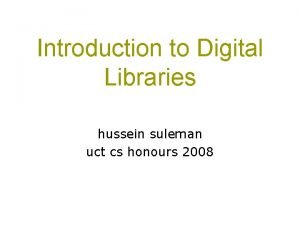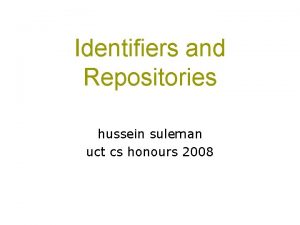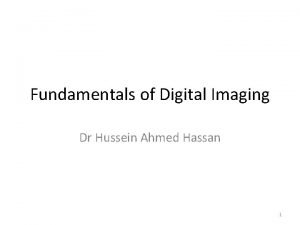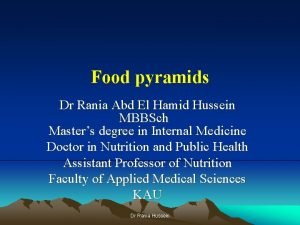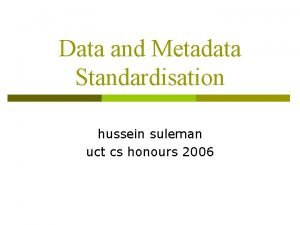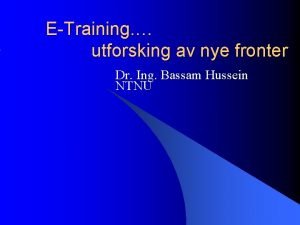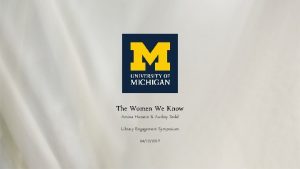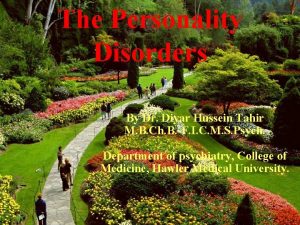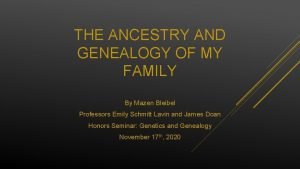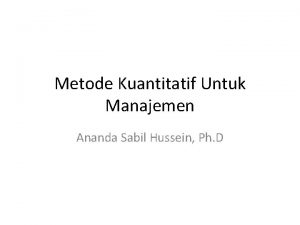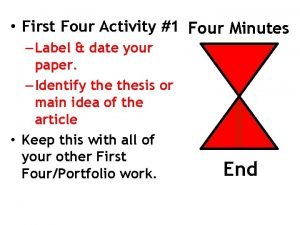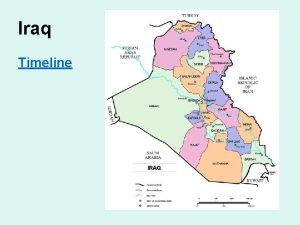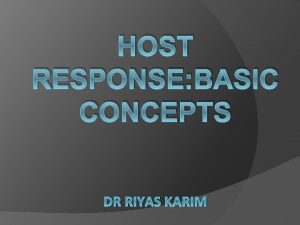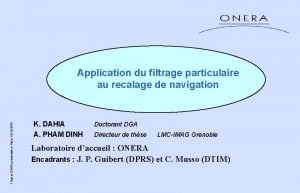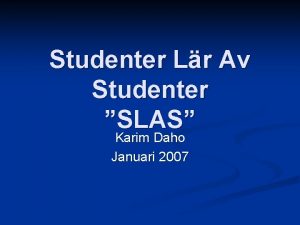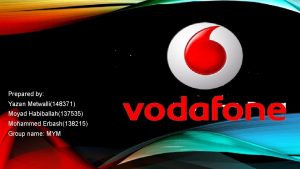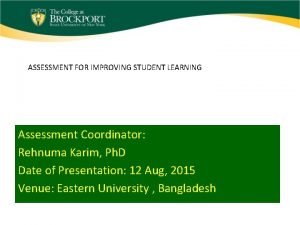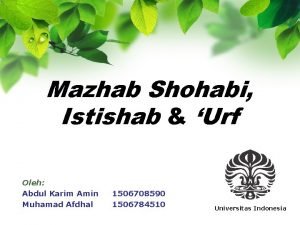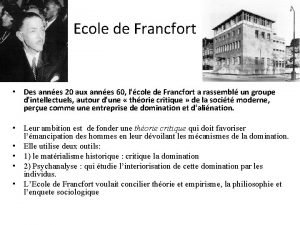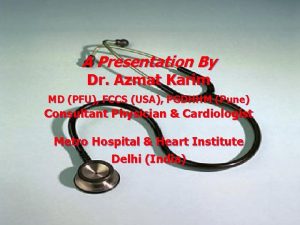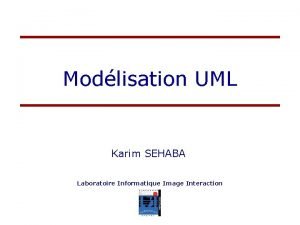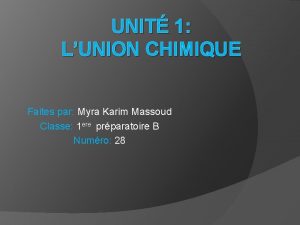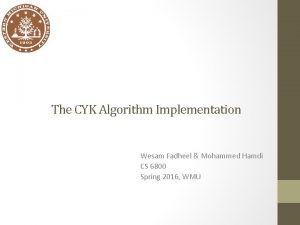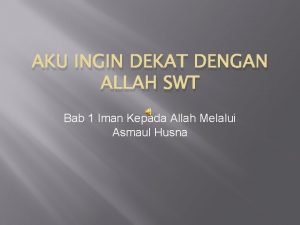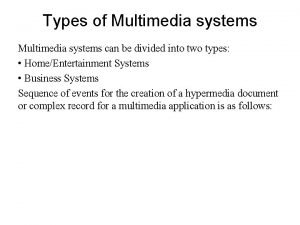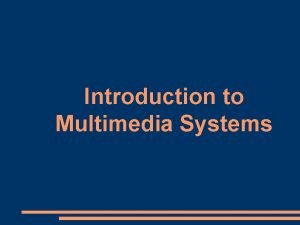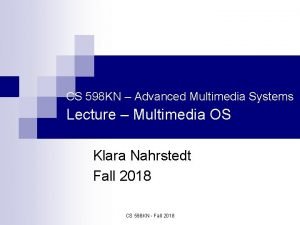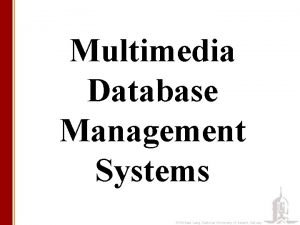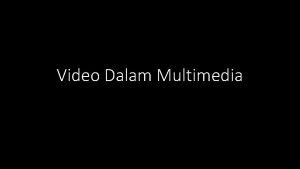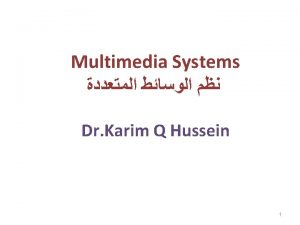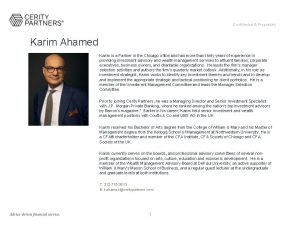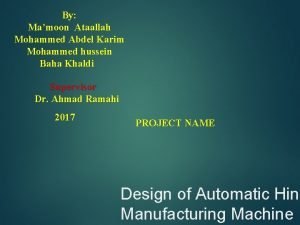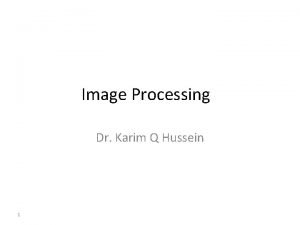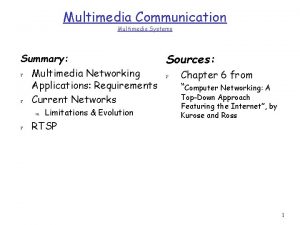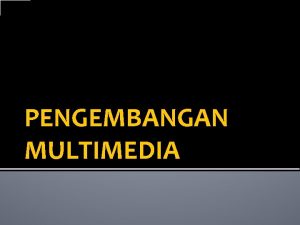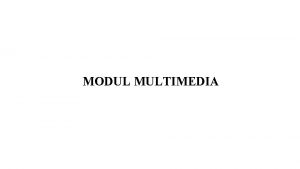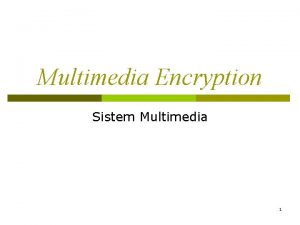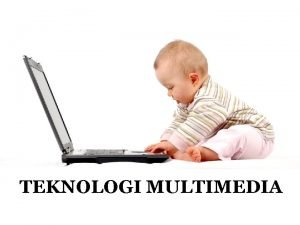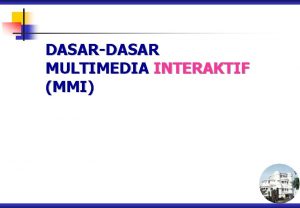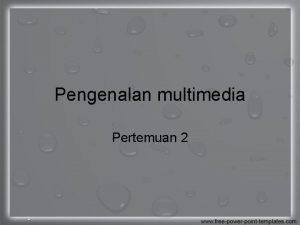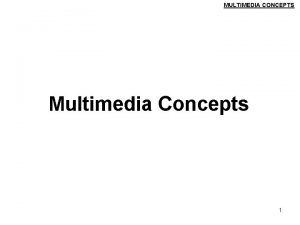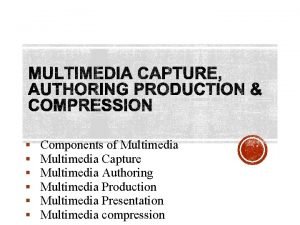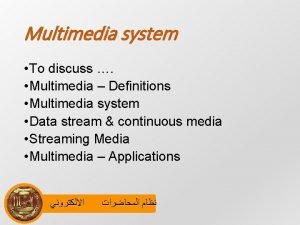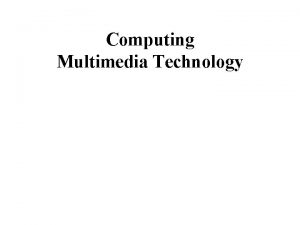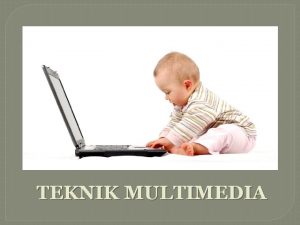Multimedia Systems Dr Karim Q Hussein 1 Definition



























































- Slides: 59

Multimedia Systems ﻧﻈﻢ ﺍﻟﻮﺳﺎﺋﻂ ﺍﻟﻤﺘﻌﺪﺩﺓ Dr. Karim Q Hussein 1

• • • Definition Introduction to Multimedia File Types Multimedia Tools Multimedia Applications 2

Definition Multimedia--the combination of text, animated graphics, video, and sound--presents information in a way that is more interesting and easier to grasp than text alone. It has been used for education at all levels, job training, and games and by the entertainment industry. It is becoming more readily available as the price of personal computers and their accessories declines. Multimedia as a human-computer interface was made possible some half-dozen years ago by the rise of affordable digital technology. 3

Previously, multimedia effects were produced by computer-controlled analog devices, like videocassette recorders, projectors, and tape recorders. Digital technology's exponential decline in price and increase in capacity has enabled it to overtake analog technology. The Internet is the breeding ground for multimedia ideas and the delivery vehicle of multimedia objects to a huge audience. 4

Multimedia--An introduction Nowadays, multimedia generally indicates a rich sensory interface between humans and computers or computer-like devices--an interface that in most cases gives the user control over the pace and sequence of the information. We all know multimedia when we see and hear it, yet its precise boundaries elude us. For example, movies on demand , in which a viewer can select from a large library of videos and then play, stop, or reposition the tape or change the speed is generally considered multimedia. 5

However, watching the movie on a TV set attached to a videocassette recorder (VCR) with the same abilities to manipulate the play is not considered multimedia. Unfortunately, we have yet to find a definition that satisfies all experts. Recent multimedia conferences, such as the IEEE International Conference on Multimedia Computing and Systems, and Multimedia Computing and Networking, provide a good start for identifying the components of multimedia 6

The range of multimedia activity is demonstrated in papers on multimedia authoring (i. e. , specification of multimedia sequences), user interfaces, navigation (user choices), effectiveness of multimedia in education, distance learning, video conferencing, interactive television, video on demand, virtual reality, digital libraries, indexing and retrieval, and support of collaborative work. 7

Multimedia systems need a delivery system to get the multimedia objects to the user. Magnetic and optical disks were the first media for distribution. The Internet, as well as the Transmission Control Protocol/Internet Protocol (TCP/IP) protocol suite or Net BIOS on isolated or campus LANs, became the next vehicles for distribution. The rich text and graphics capabilities of the World Wide Web browsers are being augmented with animations, video, and sound. Internet distribution will be augmented by distribution via satellite, wireless, and cable systems. 8

Multi Media Elements • • • Text. Graphics. Animation. Sound. Images. Videos. 9

Text n Text remains vital to multi media applications. This is because text still an effective way to communicate. n Text is used as headlines, subtitles and captions in addition to supplying contents. n Text-based menus and buttons help guide users through the multimedia applications. 10

Emphasis can be added to text by varying font size, style and color. E. g: font size 32 - point 28 - point 24 - point Font style: refers to the specific characteristics of the font. The characteristics that can be defined for fonts are italic, bold italic, subscript, superscript, blink and underline. 11

n Special effects and drop shadows give the feeling of 3 D which can be done by Word. Art. 12

Graphics n 2 D and 3 D graphics are crucial to multimedia applications. n Balancing graphics is essential, adding just the right graphics and just the right number of graphics, helps the user to learn and retain information on less time with less effort. 13

n Types of graphics 1. Clip arts: they are commercially prepared and come packaged with many applications or can be downloaded form the internet. 2. Charts: can convey a great deal of information in a very limited space. Pie charts and bar graphs are good examples of charts. 14

3) Photographs: they can be digitized through a color scanner or taken directly with digital camera. 4) Stock photographs: they are collections of digital photographs available on CD-ROM or can be downloaded from the internet. 5) Hypermedia: they are any graphic or multimedia object that serves as a link to additional information about a topic. 15

n Animation 1) It refers to graphic images that change or move. 2) Animation can convey information, add visual interest or draw attention to important information or links in multi-media applications. 3) Animation are commonly used in advertising and marketing on the web because movement grabs attention. 16

Sound: In multimedia applications digitized sound is called audio. Audio can be obtained by capturing sound into PC using a microphone or can be played from a synthesizer. n 17

n Video 1) Video can do a great deal to enhance a presentation, illustrate a proper technique or advertise a new product. 2) Video files are photographic images played at speeds that make it appear as if images are in full motion. 18

3) Video files are incredibly large because of the huge number of images (frames) to give the appearance of natural motion. E. g. : 1 second of uncompressed video running at 30 frames/second requires 30 MB of storage. 4) Bandwidth: is the amount of data a communication channel can carry. 19

n It is an obstacle to the delivery of video. n In order to efficiently communicate video files, they must be compressed or reduced in size for storage, then they are transferred and then decompressed for use. 20

Multimedia Requirements n For a digital multimedia to happen, several things have to take place: - Demand from the consumer, there is currently a debate concerning what the market actually wants as opposed to the industry’s views. - Compression techniques to make transmission viable or reduce the amount of bandwidth needed. 21

- Processing power to compression/decompression. handle the - Back channels to allow the consumer to feedback to the service provider are essential to support the billing services. 22

Overview of Multimedia Software Tools The categories of software tools briefly examined here are: 1. Music Sequencing and Notation 2. Digital Audio 3. Graphics and Image Editing 4. Video Editing 5. Animation 6. Multimedia Authoring 23

SOUND The sound file format most often used (possibly) is the Ne. XT and Sun u-law format (which is common on UNIX platforms e. g. au and MS-Dos/Windows e. g. snd). The Microsoft wav format also has a significant presence on the Internet as does the Apple AIFF format. Fortunately, conversion programs between the most common formats exist in the Public Domain and many players can handle the more common audio formats. Audio files are huge (of the order of 1 Mbyte/minute) compared to text and images files so as yet are not extensively used across the Internet but could be in an Intranet application where the loading can be from a CD or across a fast local network. 24

File-size reduction is achieved by lower sampling rates, selecting mono instead of stereo and using a data format with compression. Streaming audio is becoming more widely used by radio stations using multi -cast TCP/IP and Real. Audio. Typically the audio stream of data is not stored since it is being broadcast in real-time with many listeners hearing the same broadcast simultaneously, thus, the concept works best where there is a high bandwidth path to the listeners computer. 25

MOVIES The most prevalent (possibly) movie file format (including sound) is the ISO standard MPEG-2 format (i. e. mpeg) which has good compression and is common on most platforms. MPEG-2 is considered by many to the best of the streaming sound and movie formats. The Apple Quick. Time format (i. e. MOV) has also built up quite a big following due to the fact that some Apple computers have built-in acquisition hardware. Microsoft also has a sound and movie format known as AVI. 26

Macromedia are a specialist company who using a program called Director have created a lot of Shockwave files which are also quite prevalent. Software based viewers have very limited resolution and performance and generating MPEG requires special hardware so this is also not yet a widely used multimedia format but is likely to grow in use as Intranets and highbandwidth Internet access becomes more prevalent. 27

IMAGES Graphics file formats are plentiful e. g. gif, tiff, jpeg, xbm, ps, bmp etc. . . Fortunately, Web browsers tend to favor a couple of prevalent data types. Graphics within a HTML file can make a document more attractive and encourage a reader to return to that page. On the other hand excessive use of graphics including large files can discourage someone from reading your files and/or returning to them especially where network bandwidth is limited. 28

Multi-media files within a Web document are sent separately, even though they usually appear within the same page, thus a page with big images or even lots of small ones requires many individual transfers to take place and can be time-consuming if the communications link is slow and/or the remote host is difficult to contact. 29

Multimedia Tools • • Multimedia application enabling software Hypermedia Multimedia Authoring Tools Multimedia databases and retrieval System software support for multimedia System hardware support for multimedia Performance measurement tools for multimedia 30

Multimedia Applications • Prototype multimedia systems and platforms Education and training o Computer aided instruction o Distance and interactive training o Multimedia Encyclopedias 31

• o o o Operations Command control Process control CAD/CAM Air traffic control On-line monitoring Multimedia security systems 32

• o o o Public Digital libraries Electronic museum Network systems (medical, legal, banking, shopping, tourist) 33

• o o o Home Video on demand Interactive TV Home shopping Remote home care Electronic album Personalized electronic journals 34

• o o o o Business/Office Executive information systems Remote consulting systems Video conferencing Multimedia mail Multimedia documents Advertising Collaborative work Electronic publishing 35

History of Multimedia 1. Newspaper: perhaps the first mass communication medium, uses text, graphics, and images. 2. Motion pictures: conceived of in 1830's in order to observe motion too rapid for perception by the human eye. 3. Wireless radio transmission: Guglielmo Marconi, at Pontecchio, Italy, in 1895. 4. Television: the new medium for the 20 th century, established video as a commonly available medium and has since changed the world of mass communications. 5. The connection between computers and ideas about multimedia covers what is actually only a short period.

Hypermedia and Multimedia A hypertext system: meant to be read nonlinearly, by following links that point to other parts of the document, or to other documents (Fig. 1. 1) Hyper. Media: not constrained to be text-based, can include other media, e. g. , graphics, images, and especially the continuous media - sound and video. -The World Wide Web (WWW) - the best example of a hypermedia application. Multimedia means that computer information can be represented through audio, graphics, images, video, and animation in addition to traditional media.


Categories of Multimedia Interactive multimedia applications fall into two categories: 1) Linear media. users start at the beginning and progress through a set of sequences of events until they reach the end. E. g. : Most slide shows and plays are examples of linear media.

2) Non-linear media: they leave the order of events to the discretion of the user. There is no predefined order, users can enter or exit at any point and at any time. E. g. : - An interactive CD-ROM encyclopedia would be an example of non-linear multi-media.

World Wide Web The W 3 C has listed the following goals for the WWW: 1. Universal access of web resources (by everyone everywhere). 2. Effectiveness of navigating available information. 3. Responsible use of posted material.

History of the WWW 1960 s- The Generalized Markup Language (GML) for IBM was developed. 1986 - The ISO released a final version of the Standard Generalized Markup Language (SGML). 1990 - The Hyper. Text Markup Language (HTML) invented, and the Hyper. Text Transfer Protocol (HTTP).

1993 - NCSA released an alpha version of Mosaic based on the version by Marc Andreessen for X-Windows -the first popular browser. 1994 - formed the Netscape Communications Corporation. 1998 - The W 3 C accepted XML version 1. 0 specifications as a Recommendation - the main focus of the W 3 C and supersedes HTML.

HTTP (Hyper. Text Transfer Protocol) HTTP: a protocol that was originally designed for transmitting hypermedia, but can also support the transmission of any file type. HTTP is a stateless request/response protocol: no information carried over for the next request. The URI (Uniform Resource Identifier): an Identifier for the resource accessed, e. g. the host name, always preceded by the token http: //".

Two popular methods: GET and POST. Two commonly seen status codes: 1. 200 OK - the request was processed successfully. 2. 404 Not Found - the URI does not exist.

HTML (Hyper. Text Markup Language) HTML: a language for publishing Hypermedia on the World Wide Web - defined using SGML: 1. HTML uses ASCII, it is portable to all different (possibly binary incompatible) computer hardware. 2. The next generation of HTML is XHTML - a reformulation of HTML using XML. HTML uses tags to describe document elements: - <token params> - defining a starting point, - </token> - the ending point of the element. - Some elements have no ending tags.

A very simple HTML page is as follows: <HTML> <HEAD> <TITLE> A sample web page. </TITLE> <META NAME = "Author" CONTENT = "Cranky Professor"> </HEAD> <BODY> <P> We can put any text we like here, since this is a paragraph element. </P> </BODY> </HTML> Naturally, HTML has more complex structures and can be mixed in with other standards.

XML (Extensible Markup Language) XML: a markup language for the WWW in which there is modularity of data, structure and view so that user or application can be able to define the tags (structure). Example of using XML to retrieve stock information from a database according to a user query: 1. First use a global Document Type Definition (DTD) that is already defined. 2. The server side script will abide by the DTD rules to generate an XML document according to the query using data from your database. 3. Finally send user the XML Style Sheet (XSL) depending on the type of device used to display the information.

The current XML version is XML 2. 0, approved by the W 3 C in 2002. XML syntax looks like HTML syntax, although it is much more strict: - All tags are in lower case, and a tag that has only inline data has to terminate itself, i. e. , <token params />. - DTDs can be imported from URIs as well.

SMIL (Synchronized Multimedia Integration Language) Purpose of SMIL: it is also desirable to be able to publish multimedia presentations using a markup language. A multimedia markup language needs to enable scheduling and synchronization of different multimedia elements, and define their interactivity with the user. The W 3 C established a Working Group in 1997 to come up with specifications for a multimedia synchronization language - SMIL 2. 0 was accepted in August 2001. SMIL 2. 0 is specified in XML using a modularization approach similar to the one used in xhtml:

Multimedia Requirements n For a digital multimedia to happen, several things have to take place: - Demand from the consumer, there is currently a debate concerning what the market actually wants as opposed to the industry’s views. - Compression techniques to make transmission viable or reduce the amount of bandwidth needed.

- Processing power to compression/decompression. handle the - Back channels to allow the consumer to feedback to the service provider are essential to support the billing services.

Overview of Multimedia Software Tools The categories of software tools briefly examined here are: 1. Music Sequencing and Notation 2. Digital Audio 3. Graphics and Image Editing 4. Video Editing 5. Animation 6. Multimedia Authoring

Music Sequencing and Notation Cakewalk: now called Pro Audio. Cubase: another sequencing/editing program. Macromedia Soundedit: mature program for creating audio for multimedia projects and the web that integrates well

Digital Audio tools deal with accessing and editing the actual sampled sounds that make up audio: Cool Edit: Sound Forge: Pro Tools:

Graphics and Image Editing Adobe Illustrator: a powerful publishing tool from Adobe. Uses vector graphics; graphics can be exported to Web. Adobe Photoshop: Macromedia Fireworks: Macromedia Freehand:

Video Editing Adobe Premiere: an intuitive, simple video editing tool for nonlinear editing, i. e. , putting video clips into any order: Adobe After Effects: a powerful video editing tool that enables users to add and change existing movies. Final Cut Pro: a video editing tool by Apple; Macintosh only.

Animation Multimedia APIs: § Java 3 D: § Direct. X : Open. GL:

Multimedia Authoring Macromedia Flash: allows users to create interactive movies by using the score metaphor, i. e. , a timeline arranged in parallel event sequences. Macromedia Director: uses a movie metaphor to create interactive presentations - very powerful and includes a built in scripting language, Lingo, that allows creation of complex interactive movies.
 Karen hussein
Karen hussein Hussein bey
Hussein bey Taha hussein challenges
Taha hussein challenges Laila hussein
Laila hussein Hussein al baya
Hussein al baya Hussein suleman
Hussein suleman Hussein suleman
Hussein suleman Hussein suleman
Hussein suleman Hussein suleman
Hussein suleman Dr. hussein shaqra
Dr. hussein shaqra Mbbsch
Mbbsch Hussein suleman
Hussein suleman Bassam hussein
Bassam hussein Bismillah hir rahman ir rahim alhamdulillahi rabbil alamin
Bismillah hir rahman ir rahim alhamdulillahi rabbil alamin Audrey a. sedal
Audrey a. sedal Emptiness
Emptiness Hussein mahmood 1985
Hussein mahmood 1985 Ananda sabil hussein
Ananda sabil hussein Saddam hussein
Saddam hussein Chicken humour
Chicken humour Principles of primary health care
Principles of primary health care Dr rania hussein
Dr rania hussein Saddam hussein
Saddam hussein Dr hussein saad
Dr hussein saad William jefferson clinton apush
William jefferson clinton apush Nadya hussein
Nadya hussein Evelin karim aziz
Evelin karim aziz Karim benali
Karim benali Riyas karim
Riyas karim Al karim artinya
Al karim artinya Karim dahia
Karim dahia Transitions for thesis statements
Transitions for thesis statements Karim daho
Karim daho Yazan karim
Yazan karim Yazan karim
Yazan karim Rehnuma karim
Rehnuma karim Contoh urf
Contoh urf Karim bitar
Karim bitar Dr malabarey
Dr malabarey Karim dahia phd
Karim dahia phd Uml
Uml Prof. dr. karim fereidooni herkunft
Prof. dr. karim fereidooni herkunft Keistimewaan al quran
Keistimewaan al quran Karim massoud
Karim massoud Dr adiwarman karim
Dr adiwarman karim Karim hamdi
Karim hamdi Meneladani asmaul husna al karim
Meneladani asmaul husna al karim Multimedia becomes interactive multimedia when
Multimedia becomes interactive multimedia when Multimedia def
Multimedia def Linear and nonlinear multimedia
Linear and nonlinear multimedia Esa multimedia.esa.int./multimedia/virtual-tour-iss
Esa multimedia.esa.int./multimedia/virtual-tour-iss Types of multimedia systems
Types of multimedia systems Introduction to multimedia systems
Introduction to multimedia systems Advanced multimedia systems
Advanced multimedia systems Multimedia dbms
Multimedia dbms Decision support systems and intelligent systems
Decision support systems and intelligent systems Dicapine
Dicapine Embedded systems vs cyber physical systems
Embedded systems vs cyber physical systems Engineering elegant systems: theory of systems engineering
Engineering elegant systems: theory of systems engineering Maksud video dalam multimedia
Maksud video dalam multimedia

